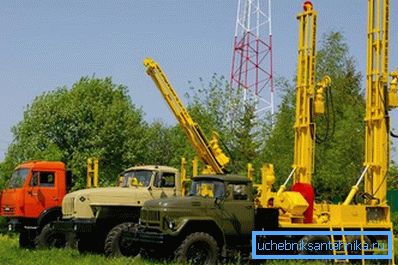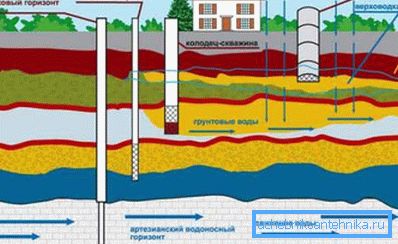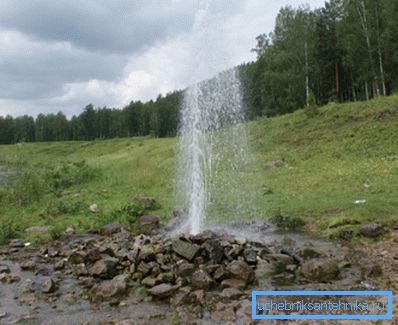What should be the depth of the artesian well
From the 12th century, underground pressure waters in the aquifers of rocks were used in the French province of Artois, and the current name derives from Aruesium, as the locality was called in Latin. But the depth of the artesian well directly depends on the location of the limestone rocks, that is, for each region it can vary significantly.
Below we will pay more attention to this issue, and also see the thematic video in this article as additional material.

Drilling of the wells
How deep you need to drill

For the provision of water in suburban areas, in most cases, independent sources of water are used, but the whole problem is that without a license you can drill up to 80 m, no deeper.
But the depth of artesian wells ranges from 30 to 250 m, and sometimes up to 300 m with a diameter of 324 mm. Therefore, for the arrangement of the so-called artesian, you will need a license permit issued in accordance with the RF Law on Subsoil.
The static and dynamic level of artesian wells is always much higher than the impermeable formation and this is achieved through the natural pressure of the water from the source. Considering the fact that such deposits of drinking resources are rich in iron ore and manganese, it is often necessary to use a filter for a well in order to comply with sanitary standards and maintain taste.
For comparison, you can see a table of indicators for different drinking sources and determine the advantages of artesian:
| Name of the indicator | Drilling on sand | Artesian well |
| Aquifer | Sands | Limestone |
| Productivity in l / hour | 500 | 3000 |
| Average duration of operation | From 2 to 10 years | Up to 50 years |
| Probability of man-made impact | maybe | Missing |
| The need for permanent water intake | Yes | Not |
| Average depth | From 5 to 30 meters | From 20 to 300 meters |
Limestone rocks, acting as a natural filter, do not allow to be contaminated (with silt or sand) to the source of water intake, thereby freeing you from unnecessary worries about cleaning that is mandatory for wells in the sand.
Also, the fact that the seasonal water level in the production pipe depends on how many meters deep the drilling was made. So, if the source is on limestone layers, then neither static nor dynamic level, depending on the season and amount of precipitation, changes.

For example, consider the aquifer resources of the city of Moscow and the Moscow region, as the most densely populated territory of the Russian Federation.
The virtually uncontrolled use of the natural resources of this region in the past has led to extreme pollution of the upper soil layers and the possibility of the emergence of natural catacombs. To assess the scale of what is happening, it should be mentioned that 20% (!) Of the entire population of Russia live in this relatively small area.
This suggests that the sandy aquifer of this region is practically unsuitable for normal use, and gradually this fate will befall or has already befallen the majority of densely populated areas of the Earth. In order to change the situation and provide the population with drinking water, it is necessary to go farther and farther and farther under the ground, and for this purpose artesian wells are drilled.
Note. It is believed that any deep well or well gives artesian water, but this is far from the case. The artesian aquifer is located only between water-resistant rocks (limestone), and has no relation to sandy clay deposits.
What does the law of the Russian Federation

- According to the law of the Russian Federation On Subsoil of February 21, 1992, as amended on December 28, 2013, artesian wells, unlike sand wells and wells, can be drilled only in those cases if you have received a license from the relevant authorities. To obtain such a permit, you will have to submit a document on the ownership of this plot or lease agreement, this is the instruction.
- After you submit the relevant documents in accordance with the applicable standards, the amount of water consumption is provided, which is provided to the water department of your city, district, region or region for approval.
- If your plot of land is suitable for organizing a sanitary zone and has at least 6060 m in accordance with paragraph 2.1.4.1110-02 SanPin, the Federal Service for Supervision of Consumer Rights Issues a conclusion to you. Construction in the sanitary zone is unacceptable, but with the approval of the CPS it is possible to narrow this perimeter to the size of 3030 m.
- Only after these procedures do you receive an opinion from the Center for State Monitoring of the State of the Subsoil or its branch for the design of an artesian well. With such a license, you can enter into an agreement with any organization engaged in deep drilling. After installation, you need to put a well on the state account, after which the entire sanitary zone and all documentation are subject to another verification from the state geological examination.

Note. The problem is that such sizes of plots (6060 m) are extremely rare, and here it turns out that the legislation contradicts housing standards. But the thing is that such arrangement of the well can be organized collectively, together with its neighbors, especially since the price of the project reaches 300,000 rubles, which is much easier to master in the clubhouse.
Conclusion
Of course, you understand that it is practically impossible to drill an artesian well with your own hands - labor costs are too high. That is why in such cases, expensive drilling equipment is used, and if you are planning such an arrangement at home, then you need to foresee a lot.